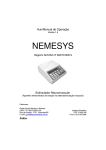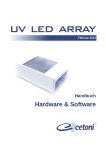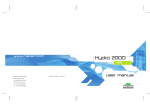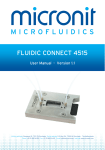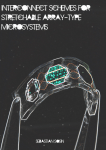Download magCHEX Manual
Transcript
neMESYS neMESYS Original User Manual 1.01 - April 2013 User Manual MAGCHEX valve cetoni GmbH Am Wiesenring 6 D- 07554 Korbußen Tel.: +49 (0) 36602 338-0 Fax: +49 (0) 36602 338-11 E-Mail: Internet: [email protected] www.cetoni.de 1. Preamble This manual is to support the user in the correct handling and the maintenance of cetoni's MAGCHEX check valves. 2. Technical Data & Handling 2.1. Wetted Materials The following sectional view shows the individual components of the MAGCHEX check valves. All parts in contact with the fluid are shown with blue identifiers, those of non-wetted parts with red identifiers. In addition, the table below details the materials. Please ensure material compatibility with the respective fluid that is to be used. 2 MAGCHEX User Manual # Description Material 1 inlet housing PPS GF40 - Polyphenylene sulfide with 2 outlet housing 40% glass fibre 3 sealing disc magnet, Parylene C-coated 4 flow seal O-ring FFKM (Perlast G60A) 5 housing seal O-ring FFKM (Perlast G80A) 6 adjustment screw [no media contact (magnet)] 2.2. Cracking Pressure Adjustment The opening or cracking pressure of the MAGCHEX is continuously adjustable between 0.1 and 0.5 bar via the adjustment screw. Fully tightened, the cracking pressure is the highest. Turn the adjustment screw counter clockwise to reduce the cracking pressure as required. The following graph plots the cracking pressure vs. the number of turns of the adjustment screw relative to the fully-tight position for the use with water and a flow rate of 5 µl/s: MAGCHEX User Manual 3 After prolonged time of nonuse, sealing disc and flow seal can stick together and cause a higher initial opening pressure. 2.3. Maximum Working & Burst Pressures The maximum working pressure of the MAGCHEX check valves is 200 bar, which may be surpassed temporarily by 50 bar. The burst pressure is 320 bar. 3. Maintenance After use with aggressive fluids, please thoroughly cleanse the check valve with distilled water followed by, if possible, drying with compressed air. If this procedure is not feasible as well as prior to extended periods of nonuse, you should disassemble and dry the valves. Otherwise, and in particular at tiny spots with insufficient/imperfect coating of the magnetic sealing disc, corrosion may occur which may limit the use time of the device. Disassembly of the valve is also necessary before changing the O-rings or the sealing disc. To do this, please proceed as follows: 4 MAGCHEX User Manual 3.1. Disassembly 1. Using a screwdriver and turning it counterclockwise, remove the adjustment screw. 2. Remove the four housing screws using a 2.5 mm hexagon socket (Allen) key. 3. Now you may remove the inlet housing part, which contains the flow seal O-ring. In case of the check valve being fixed to a mounting plate, it may be helpful to loosen the attachment screw first to prevent it from being jammed. MAGCHEX User Manual 5 mounting plate 4. Remove the remaining parts for cleaning or exchange. magnetic sealing disc outlet housing housing seal O-ring flow seal O-ring inlet housing 6 MAGCHEX User Manual 3.2. Assembly 1. Insert the housing seal into the outlet housing. Place the flow seal O-ring onto the peg of the inlet housing. 2. Take the sealing disc into one hand and the adjustment screw into the other hand. As both parts are magnets, they will push apart or pull together, depending on their respective orientation. Orient the sealing disc such that it is being pushed away from the adjustment screw. Insert the disc into the outlet housing whilst maintaining this relative orientation. IMPORTANT Please make sure to orient the magnetic sealing disc correctly during assembly. Otherwise, the valve may not close! 3. Insert the inlet housing and fix it using the four screws. Re-tighten the screw of the mounting plate. 4. Screw in the adjustment screw to its original position. MAGCHEX User Manual 7














